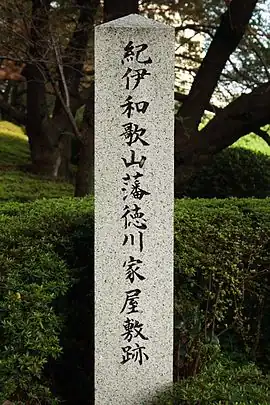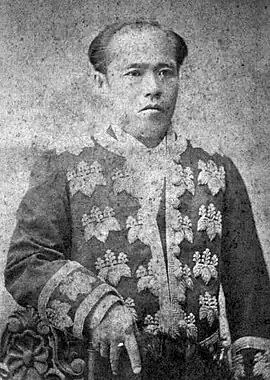| Wakayama Domain (1869–1871)和歌山藩 Kishū Domain (1600–1869)紀州藩 | |
|---|---|
| Domain of Japan | |
| 1600–1871 | |
 Mon of the Kishu-Tokugawa clan
| |
| Capital | Wakayama Castle |
| • Type | Daimyō |
| Historical era | Edo period |
• Established | 1600 |
• Disestablished | 1871 |
| Today part of | Wakayama Prefecture |


The Kishū Domain (紀州藩, Kishū-han), also known as Kii Domain (紀伊藩) or Wakayama Domain (和歌山藩), was a han or Japanese feudal domain in Kii Province. The domain spanned areas of present-day Wakayama and southern Mie prefectures, and had an income of 555,000 koku. The domain was administered from Wakayama Castle in present-day Wakayama, Wakayama Prefecture.
History
After the Battle of Sekigahara in 1600, Kii Province was given to Asano Yukinaga, the lord of Kai Province, and the Kishu Domain, which ruled the Asano family of Tozama, was established. When the Asano family was transferred to the Hiroshima Domain in Aki Province with the Kaieki of Fukushima Masayori in 1619, Tokugawa Yorinobu, the tenth son of Tokugawa Ieyasu, who had been the lord of the Sunpu Domain until then, joined the former territory of Asano with 555,000 koku, adding Minami Ise, and Kishu, the parent domain governed by the Kii Tokugawa family. The domain was established.
Yorinobu employed many ronin, and in the Keian Incident in 1651, the shogunate suspected his relationship with his ringleader, Yui Masayuki . This is said to be a rival to the Shogun family, but the details are unknown. When Tsunanori, the third lord of the domain, the grandson of Yorinobu, married Tsuruhime, the eldest daughter of the fifth shogun, Tokugawa Tsunayoshi, he was made to be the successor of Tsunayoshi without children, but he died early. After that, after many twists and turns, when Yoshimune, the younger brother of Tsunanori and the 5th lord of the domain, inherited the Shogun family and became the 8th Shogun, more than 200 feudal retainers of the Kishu clan accompanied Yoshimune and went up to Edo and were incorporated into the shogun's retainers.
Munenao, the sixth lord of the domain, who inherited the head family from the branch domain after leaving Yoshimune, overcam the financial difficulties caused by the Kyoho Famine, which lost 57% of the amount of the amount of koku, with 20,000 ryo of public money borrowed, but after that, he followed the way to make up for this budget deficit with public money. The Wakayama Domain deepened its financial dependence on the shogunate because it was close to the Shogun family, and on the other hand, this became a factor that put pressure on the shogunate's finances.
The 11th lord of the domain, Naijun, lost his worship debt during the Tenmei era, and borrowed a new 20,000 bale from the shogunate's Osaka Kurazumemai. The balance of the debt reached 45,000 ryo.
Keifuku, the 13th lord of the domain, was the grandson of the 11th Shogun Tokugawa Ienari, and in 1858, he inherited the Shogun family after Iesada, the 13th Shogun without children, and became the 14th Shogun Iemochi. All the successive shoguns after the 8th Shogun Yoshimune were occupied by the Kishu Domain and the Hitotsubashi-Tokugawa family, which was a branch of it.
In the Meiji period, it became Wakayama Prefecture due to the abolition of feudal domains and establishment of prefectures, but the eastern part of Kii Province and the territory of the Kishu Domain in Ise Province were incorporated into Mie Prefecture. [1] The heads of the domain were drawn from the Kishu-Tokugawa clan, one of the Gosanke, or three branches of the Tokugawa clan. The domain was founded by Tokugawa Yorinobu, the tenth son of the shōgun Tokugawa Ieyasu, when he moved from Sunpu Domain in Suruga Province to Kii Province. The Kishū came to control the smaller adjacent Tanabe and Shingū domains. The Kishū Domain was noted for its production of the Kishū mikan, soy sauce, lacquerware, and high-grade oak charcoal during the Edo period, and leather and cotton production by the Meiji Restoration in 1868.
Under the abolition of the han system in July 1871 the domains of Kishū, Tanabe, and Shingū became Kishū Prefecture, Tanabe Prefecture, and Shingū Prefecture respectively, and in November of the same year the three prefectures were abolished with the creation of the present-day Mie and Wakayama prefectures.[2]
List of daimyo
# Name Tenure Courtesy title Court Rank kokudaka .svg.png.webp) Asano clan, 1600 - 1619(Shinpan daimyo)
Asano clan, 1600 - 1619(Shinpan daimyo)1 Asano Yoshinaga (浅野吉永) 1600 - 1613 Sakyo no daibu (さきょうの大夫) Junior 5th Rank, Lower Grade (従五位下) 550,000 koku 2 Asano Nagaakira (浅野長明) 1613 - 1619 Uhyoe no suke (ウヒョエの助) Junior 4th Rank, Lower Grade (従五位下) 550,000 koku  Kishu-Tokugawa clan, 1619 - 1871(Shinpan daimyo)
Kishu-Tokugawa clan, 1619 - 1871(Shinpan daimyo)1 Yorinobu (徳川頼信) 1619 - 1667 Hitachi no suke (ひたちのすけ) Junior 4th Rank, Lower Grade (従五位下) 550,000 koku 2 Mitsusada (徳川光貞) 1667 - 1698 Hitachi no suke (ひたちのすけ) Junior 4th Rank, Lower Grade (従五位下) 550,000 koku 3 Tsunanori (徳川綱則) 1698 - 1705 Hitachi no suke (ひたちのすけ) Junior 4th Rank, Lower Grade (従五位下) 550,000 koku 4 Yorimoto (徳川頼本) 1705 Sakone no shoshone (サコーネのショーショーネ) Junior 4th Rank, Lower Grade (従五位下) 550,000 koku 5 Yoshimune - later became shogun (徳川吉宗) 1705 - 1716 Sakonoe gon no chujo (サコノエゴンノチュジョ) Junior 3rd Rank, Lower Grade (従五位下) 550,000 koku 6 Munenao (徳川宗正) 1716 - 1757 Genba no kami(ゲンバの神) Junior 4th Rank, Lower Grade (従五位下) 550,000 koku 7 Munemasa (徳川宗正) 1757 - 1765 Hitachi no suke (ひたちのすけ) Junior 4th Rank, Lower Grade (従五位下) 550,000 koku 8 Shigenori (徳川重則) 1765 - 1775 Hitachi no suke (ひたちのすけ) Junior 4th Rank, Lower Grade (従五位下) 550,000 koku 9 Harusada (徳川ムスタダ) 1775 - 1789 Sakon no shoshone (サコンのショーショーネ) Junior 4th Rank, Lower Grade (従五位下) 550,000 koku 10 Harutomi (徳川ハルトミ) 1789 - 1824 Hitachi no suke (ひたちのすけ) Junior 4th Rank, Lower Grade (従五位下) 550,000 koku 11 Nariyuki (徳川斉之) 1824 - 1846 Sakonoe gon no chujo(サコノエゴンノチュジョ) Junior 2nd Rank, Lower Grade (従五位下) 550,000 koku 12 Nariyuki (徳川斉之) 1846 - 1849 Sakon no chujo(サコンは最低じゃない) Junior 3th Rank, Lower Grade (従五位下) 550,000 koku 13 Yoshitomi (later became shogun (徳川義富) 1849 - 1858 Sakonoe no chujo(サコノエのチュジョ) Junior 3rd Rank, Lower Grade (従五位下) 550,000 koku 14 Mochitsugu (徳川モチツグ) 1858 - 1871 Sakonoe no chujo(サコノエのチュジョ) Junior 3rd Rank, Lower Grade (従五位下) 550,000 koku
See also
Simplified family tree
 Tokugawa Ieyasu, 1st Tokugawa Shōgun (1543-1616; r. 1603-1605)
Tokugawa Ieyasu, 1st Tokugawa Shōgun (1543-1616; r. 1603-1605)
 I. Yorinobu, 1st Lord of Kishū (cr. 1619) (1602-1671; r. 1619-1667)
I. Yorinobu, 1st Lord of Kishū (cr. 1619) (1602-1671; r. 1619-1667)
 II. Mitsusada, 2nd Lord of Kishū (1627-1705; r. 1667-1698)
II. Mitsusada, 2nd Lord of Kishū (1627-1705; r. 1667-1698)
 III. Tsunanori, 3rd Lord of Kishū (1665-1705; r. 1698-1705)
III. Tsunanori, 3rd Lord of Kishū (1665-1705; r. 1698-1705) IV. Yorimoto, 4th Lord of Kishū (1680-1705; r. 1705)
IV. Yorimoto, 4th Lord of Kishū (1680-1705; r. 1705) V. Tokugawa Yoshimune, 5th Lord of Kishū, 8th Tokugawa Shōgun (1684-1751; Lord of Kishū: 1705-1716; Shōgun: 1716-1745)
V. Tokugawa Yoshimune, 5th Lord of Kishū, 8th Tokugawa Shōgun (1684-1751; Lord of Kishū: 1705-1716; Shōgun: 1716-1745)
- Munetada, 1st head of the Hitotsubashi-Tokugawa line (1721-1765)
- Harusada, 2nd head of the Hitotsubashi-Tokugawa line (1751-1827)
 Tokugawa Ienari, 11th Tokugawa Shōgun (1773-1841; r. 1786-1841)
Tokugawa Ienari, 11th Tokugawa Shōgun (1773-1841; r. 1786-1841)
 Tokugawa Ieyoshi, 12th Tokugawa Shogun
Tokugawa Ieyoshi, 12th Tokugawa Shogun
 Tokugawa Iesada, 13th Tokugawa Shogun
Tokugawa Iesada, 13th Tokugawa Shogun
 XI. Nariyuki, 11th Lord of Kishū (1801-1846; r. 1824-1846)
XI. Nariyuki, 11th Lord of Kishū (1801-1846; r. 1824-1846)
-
 XIII. Yoshitomi, 13th Lord of Kishū, 14th Tokugawa Shōgun (as Tokugawa Iemochi) (1846-1866; Lord: 1849-1858; Shōgun: 1858-1866)
XIII. Yoshitomi, 13th Lord of Kishū, 14th Tokugawa Shōgun (as Tokugawa Iemochi) (1846-1866; Lord: 1849-1858; Shōgun: 1858-1866)
-
-
 XII. Narikatsu, 12th Lord of Kishū (1820-1849; r. 1846-1849)
XII. Narikatsu, 12th Lord of Kishū (1820-1849; r. 1846-1849)
- Narimasa, 4th head of the Tayasu-Tokugawa line (1779-1848)
- Yoshiyori, 8th head of the Tayasu-Tokugawa line (1828-1876)
- Yorimichi, 15th family head, 2nd Marquess (1872-1925; 15th family head: 1906-1925; 2nd Marquess: 1906-1925)
- Yorisada, 16th family head, 3rd Marquess (1892-1954; 16th family head: 1925-1954; 3rd Marquess: 1925-1947)
- Yoriaki, 17th family head (1917-1958; 17th family head: 1954-1958)
- Takako (b. 1926); m. Tokugawa (Aoyama) Tsuyoshi, 18th family head (b. 1924; 18th family head: 1958-1965)
- Noriko, 19th family head (b. 1956; 19th family head: 1965-present)
- Yorisada, 16th family head, 3rd Marquess (1892-1954; 16th family head: 1925-1954; 3rd Marquess: 1925-1947)
- Yorimichi, 15th family head, 2nd Marquess (1872-1925; 15th family head: 1906-1925; 2nd Marquess: 1906-1925)
- Yoshiyori, 8th head of the Tayasu-Tokugawa line (1828-1876)
- Harusada, 2nd head of the Hitotsubashi-Tokugawa line (1751-1827)
- Munetada, 1st head of the Hitotsubashi-Tokugawa line (1721-1765)
- Matsudaira Yorizumi, 1st Lord of Saijō (1641-1711)
 VI. Munenao, 6th Lord of Kishū (1682-1757; r. 1716-1757)
VI. Munenao, 6th Lord of Kishū (1682-1757; r. 1716-1757)
 VII. Munemasa, 7th Lord of Kishū (1720-1765; r. 1757-1765)
VII. Munemasa, 7th Lord of Kishū (1720-1765; r. 1757-1765)
 VIII. Shigenori, 8th Lord of Kishū (1746-1829; r. 1765-1775)
VIII. Shigenori, 8th Lord of Kishū (1746-1829; r. 1765-1775)- Matsudaira Yorikata, 6th Lord of Saijō (1755-1806)
- Matsudaira Yoriyuki, 8th Lord of Saijō (1785-1848)
- Matsudaira Yorisatō, 9th Lord of Saijō (1809-1865)
-
 XIV. Mochitsugu, 14th Lord of Kishū and family head, 1st Marquess (1844-1906; Lord: 1858-1869; Governor: 1869-1871; Marquess: 1884)
XIV. Mochitsugu, 14th Lord of Kishū and family head, 1st Marquess (1844-1906; Lord: 1858-1869; Governor: 1869-1871; Marquess: 1884)
-
- Matsudaira Yorisatō, 9th Lord of Saijō (1809-1865)
-
 X. Harutomi, 10th Lord of Kishū (1771-1853; r. 1789-1824)
X. Harutomi, 10th Lord of Kishū (1771-1853; r. 1789-1824)
- Matsudaira Yoriyuki, 8th Lord of Saijō (1785-1848)
-
 IX. Harusada, 9th Lord of Kishū (1728-1789; r. 1775-1789)
IX. Harusada, 9th Lord of Kishū (1728-1789; r. 1775-1789)
References
- ↑ "和歌山藩" [Wakayama Domain]. Kokushi Daijiten (in Japanese). Tokyo: Shogakukan. 2012. OCLC 683276033. Archived from the original on 2007-08-25. Retrieved 2012-07-21.
- ↑ "紀伊藩" [Kii Domain]. Nihon Daihyakka Zensho (Nipponika) (in Japanese). Tokyo: Shogakukan. 2012. OCLC 153301537. Archived from the original on 2007-08-25. Retrieved 2012-07-23.
- ↑ Genealogy (jp)